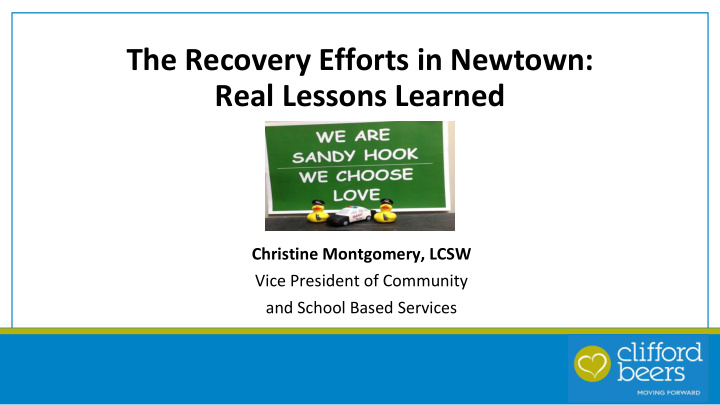



The Recovery Efforts in Newtown: Real Lessons Learned Christine Montgomery, LCSW Vice President of Community and School Based Services
ABOUT CLIFFORD BEERS • Founded in 1913 by New Haven resident Clifford W. Beers • Offers programs/services to over 5500 children and families annually • Convenient, effective care • clinic-based; school and community-based; home-based • Affiliate member of the National Childhood Traumatic Stress Network • Engaging everyone (schools, lawmakers, providers, child-focused organizations) to adopt trauma-informed practices • moving from What’s wrong with this child? to What happened to this child?
Facts about the Sandy Hook tragedy • Friday, December 14, 2012 • Timeline of the tragedy • Twenty 1 st graders and six educators were killed • All students and staff were evacuated to nearby Sandy Hook Firehouse • The school was demolished in 2014 and re-built in 2016
Immediate Following Response- Today School Years first 6 months
Multi-Level Intervention Options Tier 1 – General Population-based Interventions Psychoeducation, resiliency-based Psychological First Aid Tier 2 – Specialized Interventions Trauma/Grief-focused, short-term, strength-based SPR, CBITS, TF-CBT, CFTSI Tier 3 – Specialized Community-Based Interventions Psychiatric services, long-term treatment
Key Elements of our Support
The first six months • Joined recovery efforts at the Sandy Hook School in January • Embedded in one specific classroom • Identified two more clinicians – for student and staff support by March • Joint planning with the DBHRN team for their exit • Partnership with Yale Trauma Center until the end of that school year
Other Considerations • Victim family and survivor family support • Management of communication and the media • Handling of donations (monetary and other) • Collaboration with other similarly impacted communities • Development of the Newtown - Sandy Hook Community Foundation
Sandy Hook Recovery Team • The mission of the Sandy Hook Recovery team is to mobilize and support the Sandy Hook community to recover and thrive • Public health/ multi-tiered models of intervention to recovery from trauma
Services Provided for Students • Crisis intervention • Trauma-focused assessment and supports • Teacher consultation and classroom observation • Individual student sessions • Parent consultation and supports • Classroom wide activities • School-based group services • Referral for outside services
Year 1 – Whole School Approach • Embedded in the fabric of Sandy Hook School • Services broadly available • Clinicians assigned by grade level • Flexible referral/ identification process • Formalized screening process (CPSS and UCLA PTSD RI) • Individual treatment • Parent support • Group intervention
94% 88% 71% 65% 59% 47% 18% 12% Re-experiencing Avoidance Increased Arrousal Overall Baseline Follow up
Year 1 – Support for Staff • Embedded in the fabric of Sandy Hook School • Schedule flexibility • Safeguards staff confidentiality • Promotes professional success • Individual consultation and intervention • Group based supports and wellness activities • Referral and linkage to external supports
Year 2- Student Specific • Transition from a whole school to child specific • Sandy Hook and Reed Intermediate School • Partnership with District Recovery Director • Trauma screening and assessment continues • Two-tiered group plan • CBITS/ BounceBack! broadly implemented • Social skills/ lunch bunch groups • Parent consultation and support
Year 2- Staff support • Staff support only at Sandy Hook School • Professional strategies to mitigate the effects of trauma and promote resiliency • Wellness activities (mindfulness / in-school Weight Watchers) • Assist staff with processing next steps professionally • Transition of staff support clinician
Year 3 • Sandy Hook School only • Reduced staffing • New referrals still identified • Robust group intervention plan • Parent forums • Transition planning and letting go of the former 1 st grade class • Further redefining staff support with multiple agency involvement
Year 4 • New funding identified • Move back to Sandy Hook campus • Sandy Hook School open house events • New referrals still identified • Increased service to younger siblings now entering the school • Shift away from EBP groups to mindfulness groups • Staff support continues • Planning for the anniversary on the same campus as the shooting
Year 5 • Sandy Hook School only • Consultation as needed to other schools • New referrals still identified • Reduced staffing - no longer providing staff support • Planning for milestone anniversary – 5 th year • Next SY and considering our exit
Year 6- current school year • Transition to the middle school Re-connecting with the former 1 st graders • • Consultation to other schools as needed • New referrals still identified • Planning for Clifford Beers exit and district staffing
Significant Events • Re-location to Monroe (January 2013) • New school leadership (Summer 2013) • Bomb threat (October 2014) • Anniversary response planning for each year • Untimely death of a student (February 2015) • Transition back to Sandy Hook campus (August 2016) • Re-connecting with the most impacted class (August 2018) • Impact of other school shootings
Supervising the Recovery Team • Staff selection • Routine contact • Use of technology for check- in’s with staff • Don’t forget the basics (supplies, IT, schedule, school calendar) • Respect the “insider/outsider” dynamics • Remaining flexible, adaptive and available • Importance of on-site team support • Pay attention to secondary traumatic stress
Lessons learned ... and still learning. • Build relationships • Communication • Trauma education logistics • Logistics and measuring impact • Sensitivity to trauma triggers and anniversary preparation • Managing team wellness, transitions and departures • Capacity building and sustainability planning
Questions/Reflections Christine Montgomery, LCSW cmontgomery@cliffordbeers.org 203-777-8648 x2305 203-915-4074
Resources • Trauma/Grief resources: www.NCTSN.org • Web resources • PFA Online: http://learn.nctsn.or • CBITS: www.cbits.org • TFCBT: www.tfcbt.musc.edu • Helping Heroes: www.helping-heroes.org • Mobile apps (Apple & Android versions) • PFA Mobile • Sesame Street • PTSD Coach
Recommend
More recommend